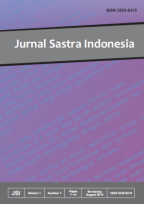ALIH WAHANA HUJAN BULAN JUNI
##plugins.themes.academic_pro.article.main##
Abstract
Penelitian ini menggunakan novel Hujan Bulan Juni dengan karya adaptasinya karya Sapardi Djoko Damono sebagi objek penelitian. Karya tersebut menjadi penting karena mengalami 3 fenomena adaptasi karya atau alih wahana. Novel yang dialih wahana dari karya (kumpulan) puisi dan akhirnya sampai ke karya film. Dari karya paling awal (puisi) ke novel, lalu ke film. Penelitian ini akan mencoba mengkaji bagaimana perjalanan alih wahana ketiga genre karya tersebut. Alih wahana Hujan Bulan Juni terjadi dua tahap. Tahap pertama adalah dari kumpulan puisi ke novel. Pada tahap ini transforamsi terjadi secara luas. Secara umum meluas dari tokoh, latar, maupun penceritaan. Demikian dari sifat imajinatif puisi menjadi konretisasi novel. Pada transformasi tahap kedua, mengalamai beberapa karakter transformasi, yaitu percakapan menjadi dialog, puisi menjadi dialog, kembali ke puisi, dan puisi novel sebagai ending film. Karya ini menurut penulis merupakan karya yang syarat dengan kedalaman makna sehingga cukup dapat dimaknai dari berbagai sudut pemaknaan.
This study uses the Rainy June novel with his adaptation work by Sapardi Djoko Damono as the object of research. The work is important because it experiences 3 phenomena of work adaptation or rides. A novel that is translated from a collection of poetry and finally to film work. From the earliest works (poems) to novels, then to films. This study will try to examine how the journey of the three genres of the work was taken. Transfer of Raindrops In June there are two stages. The first stage is from a collection of poems to novels. At this stage phosphorus occurs widely. In general, it extends from the character, background, and storytelling. Thus from the imaginative nature of poetry it becomes the concretization of the novel. In the second stage of transformation, experiencing several characters of transformation, namely conversation into dialogue, poetry becomes dialogue, returns to poetry, and poetry of novels as the ending of the film. This work according to the author is a work that conditions with the depth of meaning so that it can be interpreted from various angles of meaning.
